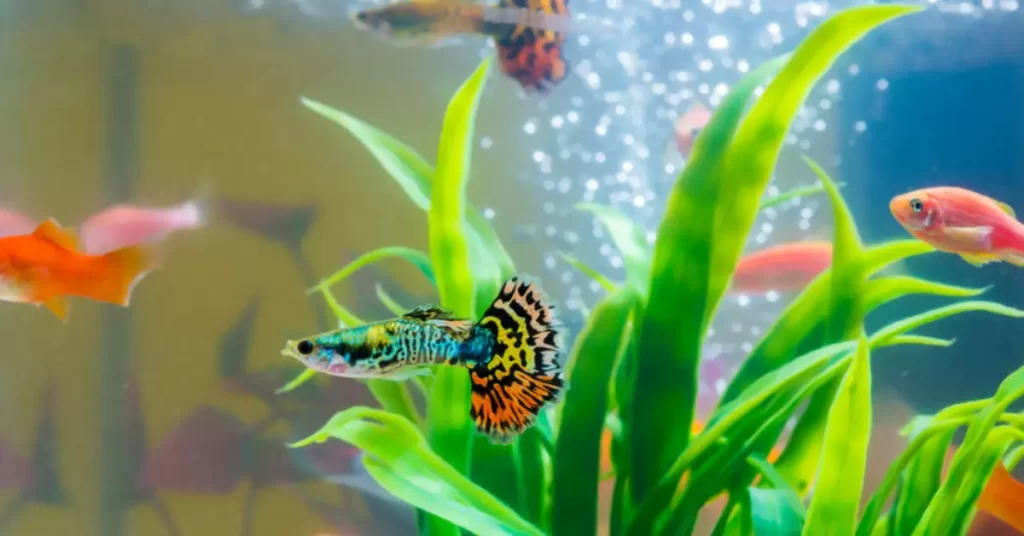Black lights have become increasingly popular in aquariums, giving a unique, otherworldly appearance to aquatic life.
However, many people wonder if black lights are safe for their fish. In this comprehensive article, we will explore the effects of black lights on fish and their safety. Let’s dive in!
Understanding Black Lights
Before we discuss the impact of black lights on fish, let’s first understand what black lights are and the types available for aquariums.
What are Black Lights?
Black lights, also known as ultraviolet (UV) lights, emit a type of light that is invisible to the human eye.
These lights produce a narrow band of wavelengths in the UV-A spectrum, typically around 365-400 nanometers, causing fluorescent materials to glow when illuminated.
Types of Black Lights for Aquariums
There are two main types of black lights commonly used in aquariums:
- Fluorescent black lights: These lights use a special phosphor coating that emits UV-A light when excited by an electric current. They are energy-efficient and produce minimal heat.
- LED black lights: LED black lights are solid-state devices that emit UV-A light directly. They are compact, energy-efficient, and have a longer lifespan than fluorescent black lights.
Effects of Black Lights on Fish
Black lights can have both positive and negative effects on fish, depending on the species and the intensity and duration of the light exposure.
Positive Effects
- Visual Enhancement: Black lights can make fish colors appear more vibrant, enhancing their natural beauty. Some fish species, such as GloFish, have been genetically modified to fluoresce under black lights, making them ideal for aquariums with UV lighting.
- Nocturnal Fish Activity: Black lights can encourage activity in nocturnal fish species without causing stress, as the light is less intense than regular aquarium lighting.
Negative Effects
- Stress: Prolonged exposure to black lights can stress some fish species, leading to a weakened immune system and increased susceptibility to disease.
- Disruption of Natural Behavior: Overexposure to black lights can disrupt the natural behavior of fish, such as their sleep-wake cycles, causing stress and other health issues.
Safety Considerations for Fish
To ensure the well-being of your fish, it is essential to follow certain guidelines when using black lights in your aquarium.
Proper Light Cycles
It’s important to maintain a proper day-night cycle for your fish. Typically, aquarium lights should be on for 8-10 hours per day, followed by a period of darkness to mimic a natural environment.
If you want to use black lights, consider turning them on for only a few hours per day or during nighttime when other lights are off. This will help reduce stress and prevent disruption of the fish’s natural behavior.
Choosing the Right Black Light
Select a black light specifically designed for aquarium use, as these lights have been tested and proven safe for aquatic life.
Avoid using black lights intended for other purposes, as they may emit harmful UV-B or UV-C radiation that can damage fish and other aquarium inhabitants.

Other Effects of Black Lights in Aquariums
Besides the impact on fish, black lights can also have other effects within an aquarium.
Algae Growth
Black lights can promote algae growth, particularly if left on for extended periods. Excessive algae can lead to poor water quality and reduced oxygen levels, which can negatively affect fish health.
To minimize algae growth, limit the duration of black light exposure and maintain proper aquarium maintenance practices, such as regular water changes and cleaning.
Aquatic Plant Health
Black lights do not provide the full spectrum of light required for healthy plant growth. If your aquarium contains live plants, it’s essential to supplement black light with other light sources that provide the necessary wavelengths for photosynthesis.
Alternatives to Black Lights
If you’re concerned about the potential negative effects of black lights on your fish, consider these alternatives:
- Moonlight LEDs: These lights emit a soft, blue glow that mimics natural moonlight and encourages nocturnal fish activity without causing stress.
- Full-spectrum LED lighting: Full-spectrum LEDs provide a range of wavelengths to support both fish and plant health while enhancing the colors of your aquatic life.
FAQs
Can black lights harm my fish?
Black lights are generally safe for fish when used correctly. However, prolonged exposure can cause stress and disrupt their natural behavior.
It’s essential to maintain proper light cycles and choose a black light specifically designed for aquarium use.
How long should I leave the black light on in my aquarium?
It’s recommended to limit black light exposure to a few hours per day or use it during nighttime when other lights are off. This helps prevent stress and disruption of the fish’s natural behavior.
Can I use black lights with live plants in my aquarium?
Black lights do not provide the full spectrum of light required for healthy plant growth. If you have live plants in your aquarium, it’s essential to supplement black light with other light sources that provide the necessary wavelengths for photosynthesis.
Conclusion
Black lights can create a visually stunning environment in an aquarium, but it’s essential to use them responsibly.
By following proper light cycles, choosing the right black light, and being aware of the effects on fish and other aquarium inhabitants, you can create a safe and beautiful aquatic environment.
If you’re still concerned about the potential effects of black lights, consider alternatives like moonlight LEDs or full-spectrum LED lighting to create an appealing ambiance without compromising the well-being of your fish.
Remember, a healthy aquarium starts with informed decisions and responsible care practices.